In this blog there are symptoms of Parkinson's Disease explained in detailed .
Don't wanna be here? Send us removal request.
Text
When to seek a Parkinson’s Diagnosis
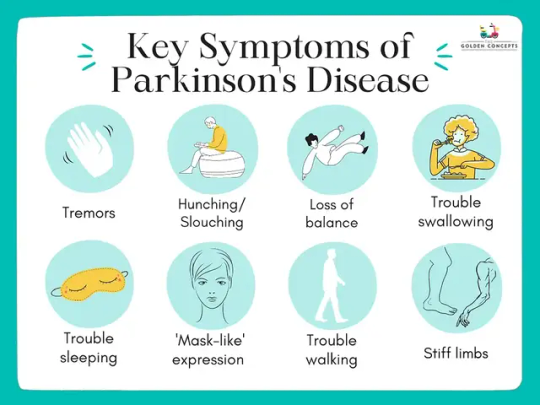
With the proliferation and easy availability of medical knowledge through the internet - many times, people tend to link their varied symptoms to specific diseases without consulting a physician.
One would not want such an occurrence with oneself or one’s family, even more so with a serious condition like Parkinson's. This article talks about when you should seek a medical diagnosis of PD.
The basic guiding factors would be the early signs that a PD-affected person starts to experience. Sometimes these are first noticed by family or friends.
Stooped posture
Family or you may notice that you have started to stoop, slouch, or lean when you are standing.
Tremors
Tremors or shaky, uncontrollable movement of a part of the body, usually occurs in one limb and is a classic sign of PD. Tremors experienced in PD tend to present when the hand is at rest and stop when the hand is active (called resting tremors). Not all tremors however indicate PD.
Continue Reading..... 📖📖
Click on the Below Link 🔗 ⬇️:
#ParkinsonsDisease#Parkinsons#ParkinsonAwareness#ParkinsonWarrior#ParkinsonCommunity#ParkinsonsDiagnosis#EarlyDiagnosis#SymptomsOfParkinsons#WhenToSeeADoctor#ParkinsonScreening#Neurology#Neuroscience#Healthcare#MedicalAdvice#HealthTips
0 notes
Text
Go with your Gut: Optimizing Diet for PD Symptoms

Have you ever heard the phrase "trust your gut"? Well, it turns out that there's more truth to it than we might have thought.
Scientists have found that the gut interacts with the brain in intricate ways, causing significant changes in our mood. While it was earlier believed that anxiety and depression can cause constipation, nausea, and other gastrointestinal symptoms, recent studies have shown that an upset gut can in turn result in anxiety and depression as well.
Hippocrates once said, "Let food be thy medicine and medicine be thy food,” a sentiment that resonates strongly with our Indian traditions of Ayurveda. While diet alone can't replace medicines, it can certainly complement their effects, thanks to the intricate relationship between our gut and brain.
Several scientists are now exploring the impact of diet on PD symptoms. While no specific diet is a “PD diet”, there are dietary interventions that can address specific bothersome issues.
In general, research suggests that some aspects of a diet can alter the severity of the symptoms and their progression rate. The main suggestions that these studies have provided are as follows-
Fresh vegetables and fruits, nuts (walnuts, pistachios, etc.), fresh herbs and spices (turmeric, cumin, coriander, mustard seed, cloves, etc. ), coconut oil, and eggs seem to be associated with reduced symptom severity and reduced rate of progression of PD symptoms. A diet rich in fresh vegetables and fruits might be beneficial for all PD patients.
Dairy intake, canned fruits and vegetables, and fried food have all been seen to increase the rate of symptom progression in PD, and avoiding these might be beneficial.
Carbidopa-levodopa, the most common PD medication, is absorbed in the small intestine. If taken together with a high-protein meal, its effect can be minimized. In order to obtain its maximum benefits, it's recommended that you accompany it with a low-protein meal, and have your protein-rich foods like lentils (dal), kidney beans (rajma), eggs, or meat at other times of the day.
Additionally, certain symptoms can also be managed better with some tweaks in everyday diet, following are some suggestions that have been reported.
Constipation- Eating food high in fiber (fruits with peel, vegetables, and legumes) and drinking more fluids can help reduce constipation. Drinking warm fluids in the morning can be specifically beneficial.
Gastroparesis (stomach takes a long time to empty its content)- Avoiding large high-fat meals has been recommended.
Nausea- Small portions of meals can help avoid feeling full. Ginger candies or ginger tea can help reduce the symptoms as well.
Low blood pressure- Eating small meals frequently, increasing fluid intake, and decreasing dehydrating drinks like coffee and alcohol can be helpful.
Swallowing problems (coughing, choking or food feeling "stuck") - Dietary changes like softened food or food that stimulates swallowing (carbonated, sour, or seasoned food) can help. Eating slower or eating small bites can also help.
Sleep Problems- Melatonin-rich fruits such as pineapple, orange, and banana might be able to help improve sleep problems. However, these should be taken in moderation.
Cognitive dysfunction- Acute caffeine consumption helps improve performance in cognitive functions. Its consumption is recommended in the military ration.
Gait and Balance- Ensuring adequate protein intake to maintain muscle strength is recommended. Foods rich in B vitamins like whole grains, eggs, and lean meats might also be beneficial.
Some supplements are also said to be beneficial but there is still a lot unknown. Make sure to talk to your doctor before starting the use of any supplement. Supplements can have unnecessary side effects that can be avoided if they are approached with caution.
Although dietary changes can help improve symptoms and symptom progression, it is important to keep in mind that the diet has no “fit-all” rule. In case, changing a certain aspect of your diet aggregates a symptom, it is advisable to revert back to your normal diet and contact a health care professional.
If you are attempting to change your diet, remember to do so in moderation. Like Sant Kabir Das said "Ati ka bhala na bolna, ati ki bhali na chup. Ati ka bhala na barsna, ati ki bhali na dhup." Moderation is the key.
#ParkinsonsDiet#GutHealthAndPD#NutritionForParkinsons#DietAndParkinsons#PDWellness#HealthyEatingForPD#ParkinsonsCare#GutBrainConnection#HolisticParkinsonsCare#ParkinsonsAwareness#PDNutritionTips#DietOptimization#LifesparkTech#FoodForBrainHealth#ParkinsonsLifestyle#neurologicaldisorders#neurology#lifesparktechnologies
0 notes
Text
Side Effects of Parkinson’s Medicines

Parkinson’s Disease results in many symptoms , some in early stages, which continue to get severe, and some develop as the disease progresses. Though, there is no cure to PD, there are many medications that are prescribed to reduce severity of the symptoms. Taking these medicines are essential to the quality of life of the PwPD as it allows them to carry on with their routine life as long as possible, and give them relief from pain and other disturbing symptoms.
Some of the medicines are known to create some side effects. This post talks about the same related information. We are going to follow the path of medicines that are commonly used by physicians, and accompanying them are narrated their commonly known side-effects.
Levodopa :
This is the most commonly used medication for PD.
In the early days of starting this medication, some PwPD feel nausea, but good news is that - many of them get over this the as body adjusts to the medicine. As Levodopa is absorbed through the gut, constipation or other stomach related problems occur for some.
After taking Levodopa for a long time, some people may have increased involuntary movements, in which case the dosage would have to be adjusted by the physician.
Other known side effects are:
1.��� Confusion
2. Mood swings
3. Sleepiness, fainting or dizziness
4. Hallucinations and delusions
5. Impulsive and compulsive behaviour
Side effects of levodopa can sometimes be improved by changing your dose, the form of the drug or how often you take it. It may also be combined with other types of drugs.
Continue Reading 📖📖.....
Click on the Below Link 🔗 👇
#ParkinsonsMedication#SideEffectsOfPDDrugs#ParkinsonsTreatment#MedicationAwareness#LivingWithParkinsons#ParkinsonsCare#PDDrugSideEffects#MovementDisorders#ParkinsonsResearch#NeurologyCare#LifesparkTech#MedicationManagement#ParkinsonsAwareness#PatientSafety#neurology#neurologicaldisorders#lifesparktechnologies
0 notes
Text
Parkinson’s - A Recognised Disability by the Indian Law
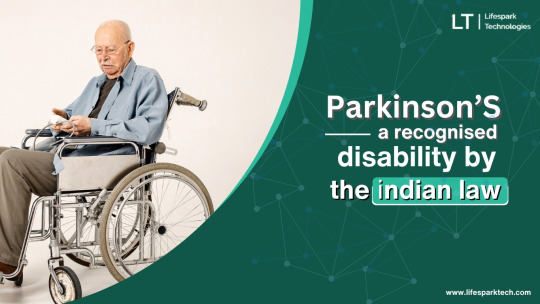
Background :
India signed the United Nations Convention on the Rights of Person with Disabilities (UNCRPD) and sometime in 2007. India subsequently fine tuned and made many amendments to the Persons with Disability Act, 1995 (PWD Act 1995) and replaced it with The Rights of PWD Act, 2016 (RPWD Act 2016). The purpose was not just to comply with the UNCRPD, but also to consider the socio-cultural setup of the Indian society and the resources available. The preamble of this act clearly states that it aims to uphold the dignity of every Person with Disability (PwD) in the society and prevent any form of discrimination.
Recognition of PD as a disability :
The new law lists 21 different conditions that are considered as disability as compared to 7 in the earlier law. In this expanded list, chronic neurological disorder based on the fact that a person with a chronic neurological condition (such as PD among others) would experience a variety of symptoms that impact their abilities to lead an independent life and would require long term healthcare and possibly assisted living. With PD, it is also recognised that it affects movement at the minimum, also speech and cognitive functioning and it will get worse with time, and thus will require more care, as it is progressive disease.
Benefits available to Person with PD :
There are several benefits and provisions available through the central and state governments to a person having PD. A disability certificate is mandatory for availing these.
Some of the main benefits are:
Railway - the person is allowed to travel in compartment reserved for the divyanjan
Air travel concession
Bus travel concession
Income tax deduction benefits - under section 80U of the IT act, A deduction of Rs. 75,000 is allowed for people with disabilities, and Rs. 1,25,000 deduction for people with severe disability. One is not required to submit any proof of medical expense to avail this deduction. If a nex of kin is paying insurance premium for a person with disability, he/she can claim deduction under section 80DD.
Note that each of the above may be subject to specific policies of central or state government prevalent at the time of availing the concession.
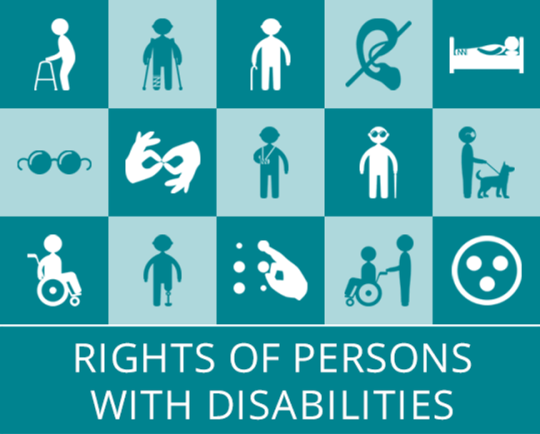
A disability certificate can only be issued by a state government hospital. This is specified for each district.
Eligibility criteria for the certificate :
Person must be an Indian citizen
Written diagnosis by a neurologist
Doctor’s prescription/s
CT or MRI scan with reports, if applicable
Detailed note about the disability, from a qualified doctor
To be issued a Disability Certificate, the individual must be assessed to have a minimum of 40% degree of disability. This assessment is done by the neurologist in the state government hospital.
#ParkinsonsAwareness#DisabilityRights#ParkinsonsAndDisability#IndianDisabilityLaw#ParkinsonsRecognition#DisabilityInIndia#LegalRights#DisabilitySupport#AccessibleIndia#RightsForParkinsons#ParkinsonsCare#PWDRecognition#DisabilityAwareness#LifesparkTech#neurology#neurologicaldisorders#lifesparktechnologies
0 notes
Text
Emotional and Psychological Effects of Parkinson’s Disease
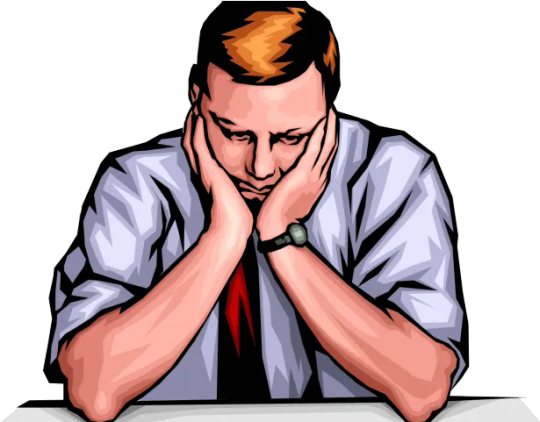
Getting diagnosed with Parkinson’s Disease is stressful for any person (Who can diagnose PD and how). Beyond acceptance of diagnosis, there is a long journey for the PwPD and the family. The journey is full of challenges, learnings and ways of defining or arranging life around the progress of condition. This involves not just the person (PwPD) but the immediate family too.
The effect of PD on physical health has been well known and it is also discussed in our article - Symptoms of PD. The treatment of the physical effects involves medication, physiotherapy and many other methods.
Subtle or Pronounced - but Yes!
However, during this journey, the PwPD and the family can experience mental and emotional impact too. If one comes across a family member of a person who has PD, one is very likely to hear them say something simila to - “Parkinson’s has made my spouse / partner / parent / sibling different.”
The changes may be subtle or more evident, but most of them feel that the loved one has changed from who they were. As for the person himself/herself, they may also notice how they think or feel about their surroundings and themselves as compared to earlier.
Is it normal?
Continue reading....📖📖
Click on the Link Below ⬇️:
#ParkinsonsAwareness#EmotionalWellbeing#PsychologicalEffects#ParkinsonsSupport#DepressionInParkinsons#AnxietyInPD#PDAndMentalHealth#LivingWithParkinsons#ParkinsonsCare#EmotionalResilience#LifesparkTech#NeurologyAndMentalHealth#ParkinsonsJourney#neurology#neurologicaldisorders#lifesparktechnologies
0 notes
Text
Why More Than Neurologists Are Needed for Parkinson's

Parkinson’s Disease (PD) is a neurological condition. Hence, it is most likely that the specialist that one sees for its diagnosis and further management would be a neurologist. And if you have access to one, then a neurologist with special interest and/or experience in managing PD.
Quality of Life for PwPD :
Note that we are using the word "manage" rather than treat. The reason being, it is a progressive disease, with no known cure as of today. PD related symptoms and PD’s progressive impact on the brain continue to get worse over the years. However, while living with PD, PwPD and their families would want to ensure that the symptoms are reduced as much as possible, such that the person can carry on with their life. Also, they would want to ensure that quality of life is maintained for as long as possible. With this aim in mind, one may be required to visit more specialists other than a neurologist. The neurologist himself/herself may in fact suggest who could help with a specific requirement.
Other specialists You Might Visit:
Your family physician -
When you start to see symptoms that seem to be PD, the first doctor you should ideally visit is your family physician. They will generally know your medical history and will direct you to a neurologist if required. If you are later diagnosed with PD, the family doctor can the be a regular guiding light for a variety of needs that may arise.
Speech Therapist -
PD many times results in speech impediments, facial expression changes and language challenges. A speech therapist can spend a few sessions, guide the PwPD and the caretaker family member to practice accordingly, and thus reduce the impact. He/she can continue the sessions depending on individual requirements.
Occupational Therapist -
When a person’s daily activities, work or leisure is impacted due to PD, then an occupational therapist may come in and help them to maintain their independence for a longer duration. They may also suggest changes in the home environment to keep the PwPD safe from falls or make their movements easier. They may teach alternative skills to carry out your regular activities. For example, they may show you how to maintain strength and flexibility in the hand to continue to write legibly. Another example of adaptive skill is slowing down the cursor speed in computer or phone so that it is easier for the PwPD to see and control.
Physiotherapist -
Exercise is very important for PwPD. Physiotherapist can show you the best exercises suiting your needs, and change them as the condition changes. Also, they can help maintain your balance and good posture despite impairments brought on by PD.
Psychologist -
The long journey of progressing PD, can have an impact on a person’s mental health. Many of them are known to experience anxiety, excessive worry or even depression. Some may also have memory problems and cognitive difficulties similar to dementia in the later stages of the disease. A trained psychologist can counsel PwPD and the family to deal with these effects. A calmer mind can aid them accept the condition rather than see it as the end of life. Therapy helps the families to adjust better to constantly evolving relationships with the affected person, as they become more dependent on the family or caregiver.
#ParkinsonsCare#NeurologyAndBeyond#ParkinsonsAwareness#HolisticParkinsonsCare#PhysicalTherapyForParkinsons#OccupationalTherapy#MovementDisorders#ParkinsonsSupport#TeamCareApproach#SpeechTherapy#ParkinsonsTreatment#LifesparkTech#ComprehensiveCare#PatientCenteredCare#walk
0 notes
Text
Understanding Freezing of Gait (UnFOG)

Have you ever experienced a sudden feeling of being glued to the ground while trying to walk? If you are an individual suffering from Parkinson's disease(PD), you might be familiar with this frustrating sensation known as Freezing of gait (FOG). It's a common disabling motor symptom in PD that can seriously impact your quality of life.
FOG doesn't always happen the same way for everyone. It can show up in different situations and be triggered by various things. By understanding these different triggers, we can classify FOG into specific types, like freezing when trying to start walking, while turning, or freezing in tight spaces like doorways. Why does this matter? Well, personalization of treatment is very important for people with PD. Different types of FOG are associated with different mechanisms, and may be benfited with different treatment. By understanding the specific type of FOG a person experiences, doctors can choose the best treatment option for them. It means better care and improved quality of life for patients dealing with FOG.
The tools we currently have for measuring FOG fall short when it comes to classifying it into different subtypes. While tests like UPDRS, FOGQ and NFOGQ are helpful for screening, they don't record the details about how FOG presents in different situations. The Freezing of Gait Severity Tool does record activities and situations that trigger FOG. However, to really understand FOG and its subtypes, we need a tool that looks at not only physical aspects but also how the brain works in different situations. These tests can help narrow down which parts of the brain might be involved in causing FOG. That’s where UnFOG scale comes into play .
Learn more about UnFOG Click at ⬇️:
#FreezingOfGait#FOGScale#ParkinsonsResearch#GaitDisorders#MovementDisorders#ParkinsonsTreatment#FOGSubtypes#NeurologyResearch#GaitAssessment#ParkinsonsAwareness#LifesparkTech#FOGMeasurement#MobilityScience#ParkinsonsMobility#LifesparkTechnologies
0 notes
Text
Parkinson’s Disease - Misdiagnosis

It is an irrefutable fact that diagnosis is vital to medical care. It creates pathways for creation and implementation of treatment plans. Conversely, we have all heard stories of people suffering due to misdiagnosis of their condition. Being not prescribed a treatment to being given wrong treatment to being confused and even worsening of their condition are all too common in all medical setups, small and big - could all stem from being misdiagnosed.
This has been observed many times with patients having Parkinson’s Disease . In a survey of 2000 people in UK, with PD, it was found that more than quarter (26%) reported they were misdiagnosed with a different condition before receiving the correct PD diagnosis.
There can be either of the below types of misdiagnosis of PD:
Initially a PD diagnosis is given, but later it turns out that it was not PD but some other condition.
Person is diagnosed with another condition, but later found that it was actually a case of PD.
There are few reasons sighted for the misdiagnosis of PD:
Continue reading......
For More information click on below link⬇️ :
#ParkinsonsMisdiagnosis#MisdiagnosedPD#MisdiagnosisAwareness#ParkinsonsSymptoms#MovementDisorders#PDConfusion#NeurologicalDisorders#AccurateDiagnosis#ParkinsonsResearch#ParkinsonsAwareness#CorrectingMisdiagnosis#NeurologyCare#ParkinsonsDiagnosticErrors
0 notes
Text
Who Can Diagnose Parkinson's disease and How ?
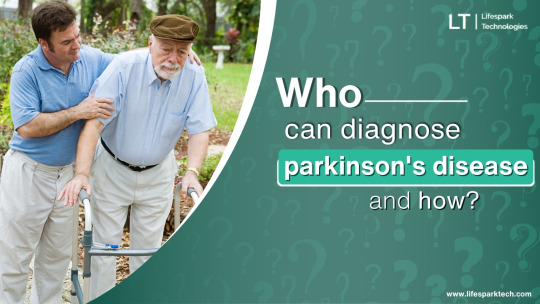
In earlier articles, we have seen early signs of Parkinson's disease (PD) as well as some guidelines when one should seek a PD diagnosis . In this article, let us understand who is qualified to diagnose PD and what are the measures they use to do so.
Most current understanding of PD says that for a person to be diagnosed as PD affected, the person must have these (International Parkinson and Movement Disorder Society (MDS)) :
Bradykinesia (slowness of movement) and one or more of the following :
Shaking or tremors in a limb that occurs while at rest
Stiffness, rigidity of arms, legs or trunk
Trouble with balance and falls
Even though your loved one may be experiencing the above, it is best to get him/her diagnosed, so that proper treatment and other lifestyle measures can be employed and better understanding of the way forward is sought. In addition, appropriate lifestyle changes and medications can slow progression of PD. Also, be aware that some symptoms that look like PD could also be caused by other medical conditions.
Whom do you approach?
If symptoms are noticed over weeks, then the first doctor you could see is your family physician. They would ideally refer you to a neurologist. Depending on where you are based, you may have access to a neurologist who is further specialized in ‘movement disorders’.
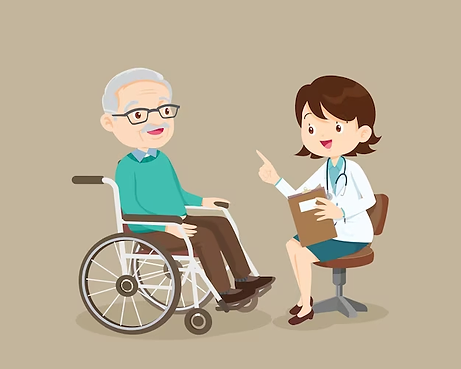
How is it diagnosed ?
Note that there is no specific lab test or imaging test that can conclusively diagnose PD. This means that the diagnosis is made were ‘clinically’ - ¹Conduct detailed assessment of the symptoms - there could be simplest of questions like :
Are you having trouble with buttoning or dressing
Do you see any changes in your handwriting
Do you have trouble brushing your teeth
And more.
Take the person’s medical and family history
Lifestyle factors that may impact the condition
Current and past medications
Do a physical examination which would centre around :
Agility of arms and legs
Any impact on expression and speech
Tremor in your extremities at rest or in action
Any stiffness in your extremities or neck
Person’s walking - step size, and ability to turn
Ability to maintain balance and examine your posture
Are there specific tests ?
While there is no conclusive test so far, certain tests such as magnetic resonance imaging of the brain (MRI brain), a dopamine transporter scan (DaT scan), or blood work can be used. MRI looks at the structure of the brain, whereas DaT scan looks at the function of the brain (as the name suggests).
Note that, none of these tests may be ordered and that is fine if the neurologist is fully satisfied about his/her clinical diagnosis.
Lastly :
The process of PD diagnosis is lengthy, as it would require more than one visit to the physician, but on a positive note it does not involve too many tests.
A proper diagnosis is key to management of PD in ensuing months and years.
#ParkinsonsDiagnosis#WhoDiagnosesPD#PDTesting#ParkinsonsSpecialist#NeurologistCare#ParkinsonsScreening#EarlyParkinsonsSigns#DiagnosingParkinsons#MovementDisorders#ParkinsonsAwareness#UnderstandingPD#ParkinsonsResearch#PDJourney#ParkinsonsCareTips#LifesparkTechnologies
0 notes
Text
Questions to ask after Parkinson's Diagnosis

Background :
There were symptoms you or your loved one had. After a few visits to doctors (family doctor / neurologist), a diagnosis of Parkinsons has been received by you.
For many families this could be the first time encounter with Parkinsons - in the sense that - they have not known anyone in the immediate family, extended family or friend circle having had this condition. They could have heard fleetingly that this results in tremors of the hands and few other symptoms.
Initial Response :
On hearing the diagnosis one may feel shocked, sad or even terrified. No matter what emotions you experience, there is a very good chance that you have no idea what to do next. There could be many questions swirling in your mind, and you do not know what more you should ask the doctor. You may want to give yourself some time alone and with family and note down questions before scheduling your next visit.
We believe that for these families, it would be good to know what they could ask the doctor/s and thus be more prepared for the journey ahead.
For More Click ⬇️
#ParkinsonsDiagnosis#PDQuestions#UnderstandingParkinsons#ParkinsonsSupport#AskYourDoctor#ParkinsonsJourney#ParkinsonsAwareness#PDResources#LivingWithParkinsons#NeurologyCare#ParkinsonsEducation#PDManagement#CopingWithParkinsons#PatientAdvocacy#ParkinsonsTreatmentOptions
0 notes
Text
Parkinson's 101

There is no simple way to deal with the life-changing event of a Parkinson’s diagnosis. The good news: Most people find acceptance and quality of life after the initial adjustment period.
What Is Parkinson's Disease?
Parkinson’s disease (PD) occurs when brain cells that make dopamine, a chemical that coordinates movement, stop working or die. Because PD can cause tremor, slowness, stiffness, and walking and balance problems, it is called a “movement disorder.” But constipation, depression, memory problems and other non-movement symptoms also can be part of Parkinson’s. PD is a lifelong and progressive disease, which means that symptoms slowly worsen over time.
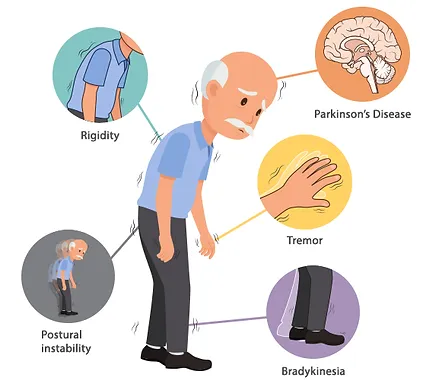
The experience of living with Parkinson's over the course of a lifetime is unique to each person. As symptoms and progression vary from person to person, neither you nor your doctor can predict which symptoms you will get, when you will get them or how severe they will be. Even though broad paths of similarity are observed among individuals with PD as the disease progresses, there is no guarantee you will experience what you see in others. Estimates suggest that Parkinson’s affects nearly 1 million people in the United States and more than 6 million people worldwide.
#parkinsonssymptoms#earlysignsofparkinsons#movementdisorders#ParkinsonsDisease#LivingWithParkinsons#PDResearch#ParkinsonsAwareness#ParkinsonsSupport#BeatParkinsons#PDWarriors#ParkinsonsCommunity#ParkinsonsTreatment#FightParkinsons#ParkinsonsCare#PDJourney#ParkinsonsEducation#Neurology#ParkinsonsAdvocacy#ParkinsonsResources#ParkinsonsLife#EndParkinsons
0 notes
Text
Who Can Diagnose Parkinson's disease and How ?

In earlier articles, we have seen early signs of Parkinson's disease (PD) as well as some guidelines when one should seek a PD diagnosis. In this article, let us understand who is qualified to diagnose PD and what are the measures they use to do so.
Most current understanding of PD says that for a person to be diagnosed as PD affected, the person must have these (International Parkinson and Movement Disorder Society (MDS)) :
Bradykinesia (slowness of movement) AND one or more of the following
Shaking or tremors in a limb that occurs while at rest
Stiffness, rigidity of arms, legs or trunk
Trouble with balance and falls
Even though your loved one may be experiencing the above, it is best to get him/her diagnosed, so that proper treatment and other lifestyle measures can be employed and better understanding of the way forward is sought. In addition, appropriate lifestyle changes and medications can slow progression of PD. Also, be aware that some symptoms that look like PD could also be caused by other medical conditions.
Whom do you approach?
If symptoms are noticed over weeks, then the first doctor you could see is your family physician. They would ideally refer you to a neurologist. Depending on where you are based, you may have access to a neurologist who is further specialised in ‘movement disorders’.

How is it diagnosed?
Note that there is no specific lab test or imaging test that can conclusively diagnose PD. This means that the diagnosis is made were ‘clinically’ - ¹Conduct detailed assessment of the symptoms - there could be simplest of questions like :
Are you having trouble with buttoning or dressing
Do you see any changes in your handwriting
Do you have trouble brushing your teeth
And more.
Take the person’s medical and family history
Lifestyle factors that may impact the condition
Current and past medications
Do a physical examination which would centre around :
Agility of arms and legs
Any impact on expression and speech
Tremor in your extremities at rest or in action
Any stiffness in your extremities or neck
Person’s walking - step size, and ability to turn
Ability to maintain balance and examine your posture
Are there specific tests?
While there is no conclusive test so far, certain tests such as magnetic resonance imaging of the brain (MRI brain), a dopamine transporter scan (DaT scan), or blood work can be used. MRI looks at the structure of the brain, whereas DaT scan looks at the function of the brain (as the name suggests).
Note that, none of these tests may be ordered and that is fine if the neurologist is fully satisfied about his/her clinical diagnosis.
Lastly:
The process of PD diagnosis is lengthy, as it would require more than one visit to the physician, but on a positive note it does not involve too many tests.
A proper diagnosis is key to management of PD in ensuing months and years.
References:
https://www.parkinson.org/understanding-parkinsons/getting-diagnosed
https://www.hopkinsmedicine.org/health/treatment-tests-and-therapies/how-parkinson-disease-is-diagnosed
https://www.webmd.com/parkinsons-disease/guide/diagnosing-parkinsons
#ParkinsonsDiagnosis#Neurology#MovementDisorders#Neurologist#DiagnosingParkinsons#ParkinsonsSymptoms#EarlySignsOfParkinsons#MovementDisorderSpecialist#ParkinsonsCare#ParkinsonsAwareness#NeurologicalDisorders#ParkinsonsResearch#MedicalDiagnosis
0 notes
Text
Symptoms of Parkinson's Disease
Parkinson's disease symptoms are different for different people. Some are hard for even doctors to detect. Others are obvious even to an untrained eye. Visit a movement disorder specialist if you think you're experiencing Parkinson's symptoms.
Motor Symptoms
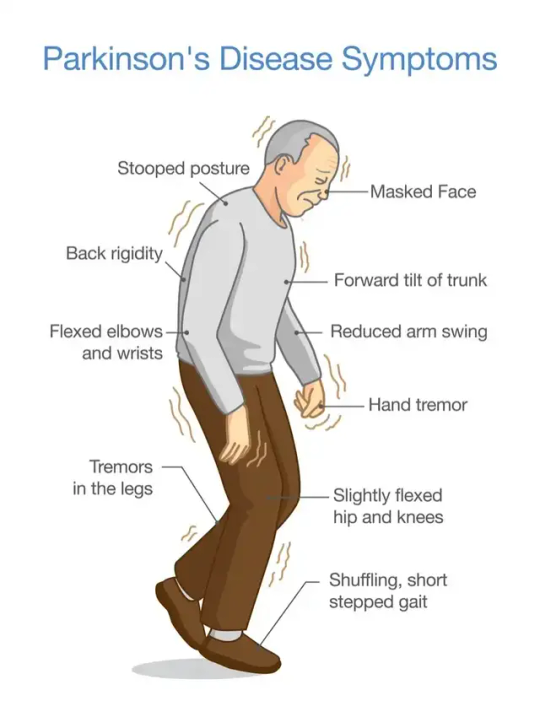
People are usually more familiar with the motor (movement) symptoms of Parkinson's disease (PD). These signs are noticeable from the outside and are used by doctors to make a diagnosis. The three "cardinal" motor symptoms of PD are:
Stiffness (rigidity): muscle stiffness detected by a doctor on examination
Slowness (bradykinesia): decrease in spontaneous and voluntary movement; may include slower walking, less arm swinging while walking, or decreased blinking or facial expression
Resting tremor: a rhythmic, involuntary shaking that occurs in a finger, hand or limb when it's relaxed and disappears during voluntary movement .
Read More .... (click👇)
#ParkinsonsSymptoms#ParkinsonsDisease#ParkinsonsAwareness#LivingWithParkinsons#PDWarriors#ParkinsonsCommunity#Rigidity#NeurologicalHealth#MovementDisorders#EarlySignsOfParkinsons#ParkinsonsManagement#ParkinsonsCare#walk
0 notes